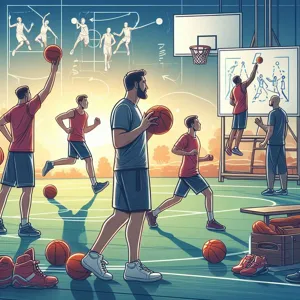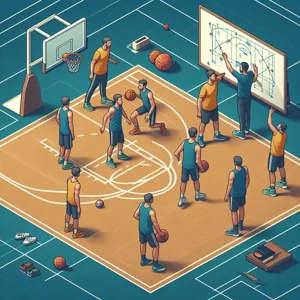In a world where quick reflexes and fast-paced action dominate the gaming landscape, strategy games offer a refreshing alternative that can challenge your intellect and sharpen your skills.
These cerebral titles demand not only quick thinking but also meticulous planning, resource management, and tactical prowess, making them perfect for those who relish the thrill of outsmarting their opponents. Whether you’re orchestrating intricate battles in vast fantasy realms, navigating political intrigue in historical settings, or building empires from the ground up, strategy games provide a rich tapestry of experiences that stimulate the mind. In this post, we’ll delve into the top 10 strategy games on PC that are sure to engage your brain and push your abilities to the limit. Get ready to strategize, adapt, and conquer as we explore the most compelling titles that will keep you on your toes and craving more!
1. Introduction to Strategy Games

Strategy games have long captivated players with their intricate mechanics, immersive worlds, and the intellectual challenge they present. These games require not just quick reflexes but also careful planning, foresight, and the ability to adapt to ever-changing scenarios. Whether you’re devising complex tactics on a battlefield, managing resources in a thriving civilization, or outsmarting opponents in a game of wits, strategy games demand a unique blend of creativity and analytical thinking.
Originating in the realm of tabletop games, the genre has evolved dramatically over the years, transitioning from simple board games to complex digital experiences that offer rich narratives and stunning graphics. The appeal of strategy games lies in their ability to engage players in deep, thoughtful gameplay, allowing for endless possibilities and approaches to victory. You’re not just playing against the game mechanics; you’re strategizing against other players or AI, predicting their moves, and adjusting your plans accordingly.
From real-time strategy (RTS) games that require quick decision-making to turn-based strategy (TBS) games that allow for meticulous planning, the genre caters to a wide range of preferences and styles. The satisfaction of outmaneuvering an opponent or successfully managing an empire is unparalleled. In this blog post, we’ll explore the top 10 strategy games on PC that will not only challenge your mind but also test your skills, providing you with countless hours of engaging gameplay. Get ready to dive into the captivating world of strategy gaming, where every decision counts and the path to victory is yours to shape!
2. Criteria for Selection
When curating a list of the top strategy games for PC, several key criteria must be taken into consideration to ensure that each title not only provides entertainment but also challenges and engages players on multiple levels.
**Gameplay Depth:** First and foremost, a game’s complexity and depth are crucial. The best strategy games often feature intricate mechanics that require players to think critically and plan several moves ahead. Look for games that offer varied strategies, allowing players to adapt their approach based on their unique playstyle or the actions of their opponents.
**Replayability:** A strong strategy game should offer high replay value. This can stem from randomly generated maps, multiple factions or characters with distinct abilities, or varied objectives that change with each playthrough. Games that keep players coming back for more, eager to test new strategies or refine old ones, are essential for this list.
**User Accessibility:** While depth is vital, accessibility should not be overlooked. A game that is too complicated or convoluted can deter new players. The best titles strike a balance, providing tutorials or gradual learning curves that allow players to grasp mechanics without feeling overwhelmed.
**Visual and Audio Design:** The aesthetic appeal of a game can significantly enhance the overall experience. High-quality graphics, immersive environments, and a compelling soundtrack can draw players into the game world, making the strategic challenges even more engaging.
**Community and Support:** Finally, the presence of a strong community and ongoing developer support is essential. Active forums and social media groups allow players to share strategies, troubleshoot issues, and connect with others who share their passion for the game. Regular updates and expansions from the developers can also keep the game fresh and exciting over time.
By adhering to these criteria, we can ensure that the strategy games we highlight not only challenge your mind but also provide an unforgettable gaming experience that tests your skills in ways you’ve never imagined. Ready to dive into some of the best strategy games available? Let’s explore our top picks!
3. Game #1: [Title]

Civilization VI is a masterclass in turn-based strategy, inviting players to build and expand their own empires from the ground up. Set in a beautifully crafted world where history meets innovation, this game challenges your mind and tests your strategic prowess like no other. You begin your journey in the ancient era, leading a fledgling civilization through the ages, from the Stone Age to the Information Age.
What sets Civilization VI apart is its intricate game mechanics that require players to think several steps ahead. You’ll need to manage resources wisely, engage in diplomacy with rival civilizations, and navigate the complexities of warfare and trade. Each decision you make can have far-reaching consequences, influencing your empire’s success or leading it to ruin.
The game’s vibrant art style and dynamic map bring every turn to life, while the rich variety of civilizations—each with unique abilities—ensures that every playthrough feels fresh and exciting. Whether you choose to dominate through military might, foster cultural development, or pursue scientific advancements, the paths to victory are numerous, allowing for endless replayability.
Multiplayer mode adds another layer of challenge, as you face off against friends or players worldwide, testing not just your strategic thinking but also your ability to negotiate and adapt. Civilization VI isn’t just a game; it’s a test of your leadership skills and strategic mindset, making it a must-play for any enthusiast looking to sharpen their tactical abilities in an immersive and intellectually stimulating environment. So gather your resources, forge alliances, and prepare to lead your civilization to greatness!
4. Game #2: [Title]
Civilization VI invites players to embark on an epic journey through history, allowing them to build and expand their own empires from the ground up. As the leader of a civilization, you are tasked with guiding your people through various eras, making strategic decisions that will impact everything from technology and culture to military and diplomacy.
The game unfolds on a beautifully crafted map, where each turn presents new opportunities and challenges. As you explore the terrain, you’ll encounter other civilizations, each with their unique strengths and weaknesses. Diplomacy becomes a critical tool as you forge alliances, negotiate trade routes, or prepare for war. The depth of strategy required is staggering—will you choose a peaceful approach to diplomacy or unleash your military might to conquer your rivals?
Civilization VI is renowned for its intricate gameplay mechanics. Players must manage resources meticulously, balancing the needs of their growing population while ensuring their military remains strong. The city-building aspect allows for creativity in urban planning, where you decide the optimal locations for districts, wonders, and infrastructure. Each decision carries weight, shaping the future of your civilization for centuries to come.
What sets Civilization VI apart is its commitment to replayability. With a multitude of civilizations to choose from, each with distinct abilities and play styles, no two games are ever the same. The dynamic interactions with AI competitors and the unpredictability of their strategies add layers of complexity that will keep you on your toes.
Whether you’re a seasoned strategist or new to the genre, Civilization VI offers a rich tapestry of challenges that will test your skills and engage your mind. Dive into this enthralling world where every turn presents a new opportunity for greatness, and discover just how deep the waters of strategy can run.
5. Game #3: [Title]

Step into the shoes of a leader in *Civilization VI*, a turn-based strategy game that redefines the genre with its intricate gameplay and expansive world. In this critically acclaimed title, players embark on a journey to build and expand their own civilization from the ground up, starting in the ancient era and progressing through the ages to modern times. The beauty of *Civilization VI* lies in its multifaceted approach to strategy—each decision you make can have far-reaching consequences, compelling you to think several moves ahead.
The game introduces the innovative “District” system, allowing you to strategically place various types of buildings in your city, which can lead to unique advantages based on your chosen play style. Whether you prefer to dominate through military might, foster cultural influence, or advance scientific research, every path offers a distinct experience. The rich tapestry of historical leaders, each with their unique abilities and agendas, adds layers of depth to your strategy as you navigate alliances and rivalries on your quest for global supremacy.
Visually, *Civilization VI* captivates with its stunning art style and vibrant animations, immersing you in a world that is alive with activity. The game’s soundtrack and voiceovers add an additional layer of immersion, as you hear the proclamations of your civilization’s progress and the consequences of your choices.
With its emphasis on diplomacy, resource management, and tactical warfare, *Civilization VI* not only challenges your strategic thinking but also tests your ability to adapt to an ever-changing world. Whether you’re a seasoned strategist or a newcomer to the genre, this game promises to engage your mind and provide countless hours of rewarding gameplay. Prepare to embark on an epic journey where every choice matters, and the fate of your civilization rests in your hands.
6. Game #4: [Title]
Civilization VI invites players into a vibrant, meticulously crafted world where strategic depth reigns supreme. As the leader of a civilization, you are tasked with guiding your people from the dawn of humanity to the modern age, and every decision you make can alter the course of history. The game’s turn-based mechanics allow you to build cities, engage in diplomacy, wage wars, and develop technologies, all while managing resources and maintaining the happiness of your citizens.
What sets Civilization VI apart is its innovative district system. Unlike previous installments, where cities were confined to a single tile, this game allows players to construct specialized districts across the map. Each district serves unique functions—such as science, culture, or military production—encouraging you to think strategically about city placement and resource allocation. This adds layers of complexity to city management, as you must consider not just the immediate benefits of your choices but how they will impact your civilization’s growth in the long run.
The game also shines in its multiplayer mode, where you can challenge friends or players from around the globe. Whether you prefer cooperative alliances or cutthroat competition, Civilization VI offers a dynamic experience that adapts to your playstyle. With each match being a unique journey shaped by your decisions, the game ensures countless hours of replayability.
Visually stunning, with a charming art style and a rich soundtrack that immerses you in the various cultures you encounter, Civilization VI is not just a game; it’s an epic saga of strategy, innovation, and conquest. Prepare to test your mental acuity and strategic prowess as you attempt to build the greatest empire the world has ever seen!
7. Game #5: [Title]

Civilization VI, the latest installment in the iconic strategy series, invites players to step into the shoes of a leader, guiding their chosen civilization from the dawn of time into the future. This turn-based strategy game is a masterclass in depth and complexity, challenging your tactical prowess and critical thinking at every turn.
In Civilization VI, the world is your canvas, and every decision you make has far-reaching consequences. You’ll begin in the ancient era, managing resources, establishing cities, and exploring uncharted territories. As you progress, you’ll navigate the intricate web of diplomacy, trade, and warfare, all while competing against legendary leaders from history. Each civilization comes with unique strengths and abilities, requiring you to adapt your strategies based on your selection.
The game’s vibrant and detailed graphics create an immersive experience, making the sprawling maps and diverse cultures come alive. The hexagonal grid system introduces a new layer of strategy, allowing for more fluid movement and a richer tactical landscape. You’ll need to carefully plan your city placements, considering factors like geography, resources, and potential threats from rival civilizations.
Civilization VI excels in its ability to present players with complex challenges that require both short-term tactics and long-term planning. Whether you’re negotiating peace treaties, engaging in espionage, or launching a full-scale invasion, each choice impacts your civilization’s development. The game also features a robust technology tree, enabling you to research advancements that can propel your civilization to new heights, whether through cultural achievements, scientific breakthroughs, or military conquests.
With its engaging gameplay, endless replayability, and a rich tapestry of historical context, Civilization VI is a must-play for any strategy enthusiast. Prepare to challenge your mind, hone your skills, and embark on an epic journey through time where every decision shapes the future of your civilization. Whether you’re a seasoned strategist or a newcomer to the genre, this game offers a rewarding and thought-provoking experience that will keep you coming back for more.
8. Game #6: [Title]
Civilization VI, the latest installment in the iconic turn-based strategy series, invites players to build and expand their own empires from the ground up. Set against a backdrop of historical epochs, you’ll start with a small tribe of settlers and guide them through the ages, making decisions that will shape the future of your civilization.
What sets Civilization VI apart is its intricate blending of strategy, diplomacy, and resource management. Players must balance military prowess with cultural advancements, technological innovations, and diplomatic relations with other civilizations. Every choice matters; from choosing where to settle your first city to managing resources and engaging in trade or warfare with neighboring nations. The game encourages players to think critically about their strategies, as the consequences of their actions can ripple through the ages.
One of the most captivating features of Civilization VI is its vibrant, colorful map that comes alive with every turn. Cities can be built on tiles that offer different resources, and the terrain plays a crucial role in both development and defense. As you advance through the game, you’ll encounter famous leaders from history, each with unique abilities that can influence your strategy.
The game also introduces a dynamic AI system that keeps players on their toes. Each civilization has its own agenda and play style, meaning that no two games are ever the same. Will you adopt a peaceful approach, forming alliances and trading with others, or opt for a more aggressive strategy, conquering your enemies one by one?
Civilization VI is perfect for those who relish a challenge and enjoy deep strategic thinking. With its engaging gameplay and endless replayability, it’s not just a game—it’s a mental workout that will keep you engrossed for hours on end. Whether you’re a seasoned strategist or a newcomer to the genre, this title is sure to test your skills and expand your tactical thinking in ways you never imagined.
9. Game #7: [Title]
Step into the tumultuous world of ancient China with *Total War: Three Kingdoms*, a masterful blend of turn-based strategy and real-time tactics that immerses players in a richly detailed historical setting. Set against the backdrop of the legendary Three Kingdoms period, this game challenges you to harness the complexities of diplomacy, warfare, and resource management as you strive for dominance over the land.
What sets *Total War: Three Kingdoms* apart from other strategy games is its emphasis on character-driven gameplay. Each general you recruit is not just a faceless unit; they come with unique personalities, skills, and relationships that can significantly influence your campaign. Players must navigate the intricate web of alliances and rivalries, utilizing both military prowess and political cunning to outsmart opponents. The dynamic system of “Lu Bu’s Might” and “Guan Yu’s Honor” adds layers of depth, showcasing how your choices can shape the trajectory of your empire.
On the battlefield, the game shines with its breathtaking visuals and epic-scale confrontations. Command thousands of troops as you deploy strategies that range from flanking maneuvers to feigned retreats. The tension of battle hangs in the air as you watch your meticulously planned tactics unfold in real-time, knowing that a single misstep could lead to disaster.
With a robust multiplayer mode, players can challenge friends or engage with a global community, testing their mettle against others who seek to conquer the Three Kingdoms. Whether you prefer to rise through cunning diplomacy or brute force, *Total War: Three Kingdoms* offers a strategic experience that will keep your mind engaged and your skills sharp. Prepare to immerse yourself in a world where every decision counts, and victory is earned through wit, strategy, and boldness.
10. Game #8: [Title]
Dive into the heart of ancient China with *Total War: Three Kingdoms*, a masterful blend of grand strategy and real-time tactics that immerses players in a richly detailed historical setting. Set during the tumultuous Three Kingdoms period, this game challenges your strategic prowess as you manage vast armies, navigate complex diplomacy, and engage in gripping battles that can change the course of history.
As a warlord striving for dominance, you’ll need to balance the demands of your empire while forging alliances and battling rival factions. The campaign map is a sprawling canvas of lush landscapes, vibrant cities, and treacherous terrain, all rendered with stunning graphics that bring the era to life. Each decision you make carries weight, from managing resources and recruiting troops to plotting your next move against relentless adversaries.
What sets *Total War: Three Kingdoms* apart is its innovative character system. Each general and character in the game possesses unique abilities and traits, allowing for diverse strategies and tactical approaches. Whether you choose to bolster your ranks with skilled warriors or employ cunning diplomacy to outmaneuver your foes, the game encourages creative thinking and adaptability.
Engaging in epic battles is where the game truly shines. The visceral excitement of commanding thousands of troops in real-time is both exhilarating and challenging. As the clash of swords and the thunder of hooves fill the air, you’ll need to employ cunning battle tactics to outsmart your opponents on the battlefield. Flanking maneuvers, ambushes, and morale management are just a few aspects you must master to emerge victorious.
With a compelling story, rich lore, and deep strategic gameplay, *Total War: Three Kingdoms* offers countless hours of immersive fun. Whether you’re a seasoned strategist or a newcomer to the genre, this game will undoubtedly challenge your mind and test your skills, making it a standout title in the pantheon of strategy games on PC. Get ready to forge your legacy in a world where cunning and courage determine the fate of nations!
11. Game #9: [Title]
As one of the most celebrated entries in the iconic Civilization series, *Civilization VI* invites players to step into the shoes of a historical leader and guide their civilization from the dawn of humanity through the ages. This turn-based strategy game is not only a test of intellect but also a deep dive into the complexities of resource management, diplomacy, and warfare.
The beauty of *Civilization VI* lies in its intricate gameplay mechanics that challenge players to think several moves ahead. You’ll strategize over everything from founding cities and managing economies to conducting espionage and forging alliances. Each decision carries weight, and the path you choose can lead to triumph or downfall. The game’s expansive tech tree and cultural development system encourage players to adopt unique strategies tailored to their preferred play style.
Visually, *Civilization VI* offers a vibrant and colorful aesthetic, with a map that comes alive as you expand your empire. The addition of districts and city planning adds another layer of strategy, as you must consider the geographical layout of your empire and optimize your cities for maximum efficiency.
Moreover, the game’s AI is both challenging and adaptive, ensuring that no two playthroughs are ever the same. Whether you’re launching a military campaign against a rival civilization or focusing on cultural dominance through tourism, *Civilization VI* provides a wealth of strategic options that will keep your mind engaged for hours on end.
With a robust multiplayer mode, you can also test your skills against friends or other players around the world, adding an extra layer of competitiveness to your experience. Prepare to immerse yourself in a world of strategy, diplomacy, and cunning as you seek to build a civilization that stands the test of time. *Civilization VI* isn’t just a game; it’s a captivating journey through history that will challenge your mind and test your skills at every turn.
12. Game #10: [Title]
As we round out our list of the top strategy games on PC, we arrive at *Civilization VI*, a title that has captivated players since its release in 2016. This turn-based strategy game invites you to build and expand your own civilization from the ground up, spanning from the ancient era to the modern age and beyond.
In *Civilization VI*, players take on the role of a leader of a nation, tasked with guiding their people through the trials and triumphs of history. The game’s beautifully rendered map is divided into hexagonal tiles, each representing different types of terrain and resources. The depth of strategy is immense, as you must balance military might, technological advancement, cultural development, and diplomatic relations with other civilizations.
What sets *Civilization VI* apart is its engaging gameplay mechanics. City management has evolved, allowing for more strategic placement of buildings and districts, which can significantly influence your civilization’s growth and productivity. Furthermore, the introduction of “Eureka moments” rewards you for completing specific tasks that can accelerate your technological research, making every decision you make impactful.
Multiplayer mode also enhances the experience, enabling you to challenge friends or players around the world, testing your strategic prowess against real-life opponents. The game’s replayability is virtually endless, thanks to a myriad of civilizations to choose from, each with unique abilities and units, ensuring that no two games are ever the same.
Whether you’re a seasoned strategist or a newcomer to the genre, *Civilization VI* offers a rich tapestry of history, strategy, and decision-making that will challenge your mind and keep you engaged for countless hours. As you navigate the complexities of empire-building, you’ll find yourself not just playing a game, but participating in a grand historical narrative that spans the ages.
13. Tips for Improving Your Strategy Game Skills
Improving your strategy game skills is a journey that requires patience, practice, and a willingness to learn from both your successes and failures. Here are some effective tips to elevate your gameplay and sharpen your strategic acumen.
**1. Study the Game Mechanics:**
Before diving into a new strategy game, take the time to thoroughly understand its mechanics. Read the game manual, watch tutorial videos, and familiarize yourself with the different units, resources, and strategies available. Knowing the ins and outs of the game will give you a solid foundation to build upon.
**2. Analyze Your Gameplay:**
Record your sessions or take notes after each match. Reflect on what worked well and what didn’t. Identifying your mistakes is just as important as recognizing your victories. By understanding your decision-making process during critical moments, you can refine your approach in future games.
**3. Learn from Others:**
Watch streams or videos of skilled players. Platforms like Twitch and YouTube are treasure troves of strategy game content, where you can observe advanced techniques and unconventional strategies. Pay attention to how top players manage their resources, position their units, and respond to opponents’ moves.
**4. Practice, Practice, Practice:**
Like any skill, becoming proficient at strategy games requires practice. Regularly play to build muscle memory and enhance your reflexes. Try different strategies to see what works best for your playstyle. Don’t shy away from playing against more experienced opponents; they can provide valuable lessons.
**5. Join a Community:**
Engage with fellow gamers in forums, Discord servers, or social media groups dedicated to your chosen game. These communities often share tips, strategies, and insights that can profoundly enhance your understanding and enjoyment of the game. Plus, discussing strategies and sharing experiences can provide fresh perspectives that inspire your gameplay.
**6. Stay Calm Under Pressure:**
Strategy games often involve high-stakes decisions with time constraints. Practice staying calm and composed, even when the pressure mounts. This mental resilience will help you think clearly and make more rational decisions, ultimately leading to better outcomes in tense situations.
**7. Experiment and Adapt:**
Don’t be afraid to try out different strategies and tactics, even if they initially seem unconventional. The beauty of strategy games lies in their complexity and the myriad of ways to approach challenges. Adapt your strategies based on your opponents and learn to pivot when necessary.
By incorporating these tips into your gaming routine, you’ll be well on your way to becoming a more formidable strategist. With dedication and a keen sense of adaptability, you’ll not only improve your skills but also gain a deeper appreciation for the intricate world of strategy games. Happy gaming!
14. The Future of Strategy Games on PC
The future of strategy games on PC is poised for an exciting transformation that promises to elevate the genre to new heights. As technology continues to advance, developers are exploring innovative ways to enhance gameplay, storytelling, and player engagement. One of the most significant trends shaping the landscape is the integration of artificial intelligence. AI-driven opponents will become increasingly sophisticated, adapting to player strategies and providing a more challenging and dynamic gaming experience.
Moreover, the rise of cloud gaming services is set to make strategy games more accessible than ever. Players will no longer be limited by hardware capabilities; instead, they can dive into complex simulations and visually stunning worlds from various devices. This democratization of gaming can lead to a broader audience, allowing more players to engage with intricate strategy mechanics and narratives.
Additionally, the community aspect of strategy games will be further enriched through enhanced multiplayer experiences. Expect to see more seamless online interactions, cooperative missions, and competitive leagues that foster a sense of camaraderie and rivalry among players. This social dimension not only deepens the gaming experience but also encourages the sharing of strategies, tips, and innovative tactics.
Lastly, we may witness a resurgence of hybrid games that blend genres, incorporating elements from role-playing games (RPGs), real-time strategy (RTS), and even first-person shooters (FPS). This genre-blending will create fresh gameplay mechanics and narratives, keeping players engaged and challenged in ways they’ve never experienced before.
As we look ahead, it’s clear that the future of strategy games on PC is bright, filled with opportunities for innovation and creativity. Whether you’re a seasoned tactician or a newcomer to the genre, the evolving landscape promises to offer an array of challenging experiences that will test your skills and ignite your strategic thinking. Embrace the journey and get ready for the strategic battles that await!
15. Conclusion: Finding Your Next Challenge
In the vast landscape of strategy gaming, the quest for the next great challenge is both exhilarating and rewarding. As we’ve explored the top 10 strategy games on PC, it’s clear that each title offers a unique blend of tactics, creativity, and skill that can captivate both seasoned gamers and newcomers alike. Whether you’re leading a medieval army to victory, constructing a sprawling civilization, or navigating the complexities of political intrigue, these games are designed to push your mental faculties to the limit.
As you venture into this world of strategic thinking, consider what aspects of gameplay resonate most with you. Do you thrive on the thrill of real-time decision-making, or do you prefer the methodical pace of turn-based tactics? Are you drawn to historical settings, or do you find yourself captivated by fantastical realms? Finding a game that aligns with your interests will not only enhance your gaming experience but will also ensure that you remain engaged and challenged.
With each game on this list, you’ll discover opportunities to hone your skills, adapt your strategies, and immerse yourself in intricate narratives. The beauty of strategy games lies in their ability to reward thoughtful planning and foresight, making every victory feel earned and every defeat a lesson in resilience.
So, gear up, gather your wits, and dive into one of these compelling titles. Each game is a doorway to new challenges and experiences that will sharpen your mind and test your skills. The next great adventure awaits—are you ready to conquer it?
In conclusion, the world of strategy games on PC offers a vast array of exhilarating experiences that not only challenge your mind but also sharpen your problem-solving skills. From the intricate tactics of real-time battles to the deep, turn-based planning of empire-building, each game on our list invites you to immerse yourself in strategic thinking and creativity. Whether you’re a seasoned strategist or just beginning your journey into this captivating genre, these top ten games promise countless hours of engaging gameplay and mental stimulation. So gather your resources, devise your plans, and get ready to conquer new worlds—your next great gaming adventure awaits! Which game will you dive into first?
























